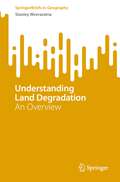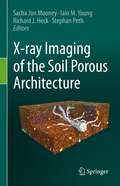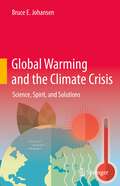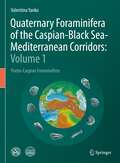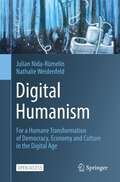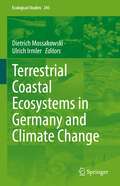- Table View
- List View
From Dissent to Diplomacy: The Pugwash Project During the 1960s Cold War (SpringerBriefs in History of Science and Technology)
by Alison KraftThis book provides new and critical perspectives on the internal development of the Pugwash Conferences on Science and World Affairs (the PCSWA; Pugwash) and its role in international nuclear diplomacy during the 1960s Cold War. Conceived by western scientists dissenting from their own government’s position on nuclear weapons, the conferences brought together elite scientists from across the East-West divide to work towards nuclear disarmament and for peace. The analysis follows two lines. First, the book charts the emergence during the conferences of a distinctive form of technopolitical communication that was crucial to the role of Pugwash in Informal cross-bloc dialogue about disarmament. This enabled Pugwash to realize its paradoxical vision of working both with and against governments to promote disarmament and was key to its role as both a forum for and actor within the realm of informal diplomacy. It is argued that Pugwash scientists formed the vanguard of what came in the 1960s to be called Track II diplomacy. The relevance of the contemporary concept of Science Diplomacy for Pugwash is discussed. The second analytical focus of the book centers on the internal dynamics of the international Pugwash organization. It is argued that informal modes of working and a code of confidentiality accorded the leadership enormous power and autonomy: this small network of senior figures was able to control the Pugwash agenda and priorities, and to launch diplomatic initiatives beyond the conferences. However, by 1967, competing interests were fueling tensions and instability within Pugwash as it struggled for coherence and direction amid with the political challenges posed by the Vietnam War and European security. This crisis manifest the limits of the Pugwash project and placed its future in doubt.
Understanding Land Degradation: An Overview (SpringerBriefs in Geography)
by Stanley WeeraratnaMuch of the earth's population is dependent on agriculture as it provides food for their sustenance. Successful crop production depends to a considerable extent on land and climate. Soil is the main component of land and a fertile soil is essential for crop growth. However, soil fertility declines over the years mainly due to land degradation. Hence, implementing appropriate measures to control land degradation is important. It is the responsibility of the farmers and the governments to take action to control land degradation. Agricultural extension officers are involved in making farmers aware of land degradation and control measures. Planners and policy makers need scientific assessments on land degradation and its implications so that they could advice the relevant authorities who prepare the national programs and budgets. This book highlights issues related to land degradation, the causal factors and methods of control. The audience is agricultural practitioners and planners as well as students of agriculture. Environmentalists would also benefit by understanding the main issues related to land degradation discussed.
Human Aspects of Information Security and Assurance: 16th IFIP WG 11.12 International Symposium, HAISA 2022, Mytilene, Lesbos, Greece, July 6–8, 2022, Proceedings (IFIP Advances in Information and Communication Technology #658)
by Nathan Clarke Steven FurnellThis book constitutes the proceedings of the 16th IFIP WG 11.12 International Symposium on Human Aspects of Information Security and Assurance, HAISA 2022, held in Mytilene, Lesbos, Greece, in July 2022. The 25 papers presented in this volume were carefully reviewed and selected from 30 submissions. They are organized in the following topical sections: cyber security education and training; cyber security culture; privacy; and cyber security management.
X-ray Imaging of the Soil Porous Architecture
by Sacha Jon Mooney Iain M. Young Richard J. Heck Stephan PethThe advent of X-ray Computed Tomography (CT) as a tool for the soil sciences almost 40 years ago has revolutionised the field. Soil is the fragile, thin layer of material that exists above earth’s geological substrates upon which so much of life on earth depends. However a major limitation to our understanding of how soils behave and function is due to its complex, opaque structure that hinders our ability to assess its porous architecture without disturbance. X-ray imagery has facilitated the ability to truly observe soil as it exists in three dimensions and across contrasting spatial and temporal scales in the field in an undisturbed fashion. This book gives a comprehensive overview of the “state of the art” in a variety of application areas where this type of imaging is used, including soil water physics and hydrology, agronomic management of soils, and soil-plant-microbe interactions. It provides the necessary details for entry level readers in the crucial areas of sample preparation, scanner optimisation and image processing and analysis. Drawing on experts across the globe, from both academia and industry, the book covers the necessary “dos and don’ts”, but also offers insights into the future of both technology and science. The wider application of the book is provided by dedicated chapters on how the data from such imagery can be incorporated into models and how the technology can be interfaced with other relevant technical applications. The book ends with a future outlook from the four editors, each of whom has over 20 years of experience in the application of X-ray CT to soil science.
Cosmology in the Early Modern Age: A Web of Ideas (Logic, Epistemology, and the Unity of Science #56)
by Paolo Bussotti Brunello LottiThis volume addresses the history and epistemology of early modern cosmology. The authors reconstruct the development of cosmological ideas in the age of ‘scientific revolution’ from Copernicus to Leibniz, taking into account the growth of a unified celestial-and-terrestrial mechanics. The volume investigates how, in the rise of the new science, cosmology displayed deep and multifaceted interrelations between scientific notions (stemming from mechanics, mathematics, geometry, astronomy) and philosophical concepts. These were employed to frame a general picture of the universe, as well as to criticize and interpret scientific notions and observational data.This interdisciplinary work reconstructs a conceptual web pervaded by various intellectual attitudes and drives. It presents an historical–epistemological unified itinerary which includes Copernicus, Kepler, Galileo, Descartes, Huygens, Newton and Leibniz. For each of the scientists and philosophers, a presentation and commentary is made of their cosmological views, and where relevant, outlines of their most relevant physical concepts are given. Furthermore, the authors highlight the philosophical and epistemological implications of their scientific works. This work is helpful both as a synthetic overview of early modern cosmology, and an analytical exposition of the elements that were intertwined in early-modern cosmology. This book addresses historians, philosophers, and scientists and can also be used as a research source book by post-graduate students in epistemology, history of science and history of philosophy.
Harmonic Analysis in Operator Algebras and its Applications to Index Theory and Topological Solid State Systems (Mathematical Physics Studies)
by Hermann Schulz-Baldes Tom StoiberThis book contains a self-consistent treatment of Besov spaces for W*-dynamical systems, based on the Arveson spectrum and Fourier multipliers. Generalizing classical results by Peller, spaces of Besov operators are then characterized by trace class properties of the associated Hankel operators lying in the W*-crossed product algebra. These criteria allow to extend index theorems to such operator classes. This in turn is of great relevance for applications in solid-state physics, in particular, Anderson localized topological insulators as well as topological semimetals. The book also contains a self-contained chapter on duality theory for R-actions. It allows to prove a bulk-boundary correspondence for boundaries with irrational angles which implies the existence of flat bands of edge states in graphene-like systems.This book is intended for advanced students in mathematical physics and researchers alike.
Non-equilibrium Thermodynamics (Lecture Notes in Physics #1007)
by Andrea Di VitaThe importance of thermodynamics, particularly its Second Principle, to all branches of science in which systems with very large numbers of particles are involved cannot be overstated. This book offers a panoramic view of non-equilibrium thermodynamics. Perhaps the two most attractive aspects of thermodynamic equilibrium are its stability and its independence from the specifics of the particular system involved. Does an equivalent exist for non-equilibrium thermodynamics? Many researchers have tried to describe such stability in the same way that the Second Principle describes the stability of thermodynamic equilibrium - and failed. Most of them invoked either entropy, or its production rate, or some modified version of it. In their efforts, however, those researchers have found a lot of useful stability criteria for far-from-equilibrium states. These criteria usually take the form of variational principles, in terms of the minimization or maximization of some quantity. The aim of this book is to discuss these variational principles by highlighting the role of macroscopic quantities. This book is aimed at a wider audience than those most often exposed to the criteria described, i.e., undergraduates in STEM, as well as the usual interested and invested professionals.
Soybean Improvement: Physiological, Molecular and Genetic Perspectives
by Shabir Hussain Wani Najeeb ul Rehman Sofi Muhammad Ashraf Bhat Feng LinSoybean (Glycine max L. (Merr)) is one of the most important crops worldwide. Soybean seeds are vital for both protein meal and vegetable oil. Soybean was domesticated in China, and since last 4-5 decades it has become one of the most widely grown crops around the globe. The crop is grown on an anticipated 6% of the world’s arable land, and since the 1970s, the area in soybean production has the highest percentage increase compared to any other major crop. It is a major crop in the United States, Brazil, China and Argentina and important in many other countries. The cultivated soybean has one wild annual relative, G. soja, and 23 wild perennial relatives. Soybean has spread to many Asian countries two to three thousand years ago, but was not known in the West until the 18th century. Among the various constraints responsible for decrease in soybean yields are the biotic and abiotic stresses which have recently increased as a result of changing climatic scenarios at global level. A lot of work has been done for cultivar development and germplasm enhancement through conventional plant breeding. This has resulted in development of numerous high yielding and climate resilient soybean varieties. Despite of this development, plant breeding is long-term by nature, resource dependent and climate dependent. Due to the advancement in genomics and phenomics, significant insights have been gained in the identification of genes for yield improvement, tolerance to biotic and abiotic stress and increased quality parameters in soybean. Molecular breeding has become routine and with the advent of next generation sequencing technologies resulting in SNP based molecular markers, soybean improvement has taken a new dimension and resulted in mapping of genes for various traits that include disease resistance, insect resistance, high oil content and improved yield.This book includes chapters from renowned potential soybean scientists to discuss the latest updates on soybean molecular and genetic perspectives to elucidate the complex mechanisms to develop biotic and abiotic stress resilience in soybean. Recent studies on the improvement of oil quality and yield in soybean have also been incorporated.
Microbiology of Ethanol Fermentation in Sugarcane Biofuels: Fundamentals, Advances, and Perspectives
by Sandra Regina Ceccato-AntoniniThis book discusses the microbiology of fermentation for the production of bioethanol from sugarcane. Coverage includes how selected yeasts improve ethanol yield and productivity concerning recent advances at genomic, transcriptomic, and proteomic levels, how microorganisms (bacteria and yeasts) interact with each other in fermentation vats, and the application of microbiological monitoring methods with safety and precision. Special attention is given to antimicrobial strategies used to decrease contamination. The book is aimed at professionals working in the bioethanol industry, as well as students and researchers studying biological and biotechnological aspects of applied matters such as industrial microbiology and industrial fermentations. The English translation of this book from its Portuguese original manuscript was done with the help of artificial intelligence (machine translation by the service provider DeepL.com). A subsequent human revision of the content was done by the author. Covers common microbiological monitoring techniques;Reviews selected yeasts used in the bioethanol industry;Examines the role of bacteria and native yeasts in ethanolic fermentation and methods to control their growth.
Progress in Sustainable Aviation (Sustainable Aviation)
by T. Hikmet Karakoc Can Ozgur Colpan Alper DalkiranProgress in Sustainable Aviation looks at recent progress and new technological developments in sustainable aviation, presenting readers with engineering solutions and methodologies for efficiency and cost savings, performance improvement, and emission reduction. Coverage includes alternative fuel types, propulsion technologies, and emission technologies used in different aerial vehicles, such as unmanned aerial vehicles, drones, and passenger aircraft. Operational areas, such as the building of green airports, commercial air transport, and maintenance management are also addressed. This collection will be a valuable reference for researchers, practicing engineers, scientists, and students working in the area of sustainable aviation technology and management. Looks at recent progress in sustainable aviation technologies;Presents alternative aviation fuel types and propulsion technologies;Includes case studies and practical applications.
Leonhard Euler and the Foundations of Celestial Mechanics (History of Physics)
by Dora MusielakThe intention of this book is to shine a bright light on the intellectual context of Euler’s contributions to physics and mathematical astronomy. Leonhard Euler is one of the most important figures in the history of science, a blind genius who introduced mathematical concepts and many analytical tools to help us understand and describe the universe. Euler also made a monumental contribution to astronomy and orbital mechanics, developing what he called astronomia mechanica. Orbital mechanics of artificial satellites and spacecraft is based on Euler’s analysis of astromechanics. However, previous books have often neglected many of his discoveries in this field. For example, orbital mechanics texts refer to the five equilibrium points in the Sun-Earth-Moon system as Lagrange points, failing to credit Euler who first derived the differential equations for the general n-body problem and who discovered the three collinear points in the three-body problem of celestial mechanics. These equilibrium points are essential today in space exploration; the James Webb Space Telescope (successor to the Hubble), for example, now orbits the Sun near L2, one of the collinear points of the Sun-Earth-Moon system, while future missions to study the universe will place observatories in orbit around Sun-Earth and Earth-Moon equilibrium points that should be properly called Euler-Lagrange points. In this book, the author uses Euler’s memoirs, correspondence, and other scholarly sources to explore how he established the mathematical groundwork for the rigorous study of motion in our Solar System. The reader will learn how he studied comets and eclipses, derived planetary orbits, and pioneered the study of planetary perturbations, and how, old and blind, Euler put forward the most advanced lunar theory of his time.
Indigenous Methodologies, Research and Practices for Sustainable Development (World Sustainability Series)
by Marcellus F. Mbah Walter Leal Filho Sandra AjapsThis book states that whilst academic research has long been grounded on the idea of western or scientific epistemologies, this often does not capture the uniqueness of Indigenous contexts, and particularly as it relates to the achievement of the United Nations Sustainable Development Goals (SDGs). The SDGs were announced in 2015, accompanied by 17 goals and 169 targets. These goals are the means through which Agenda 2030 for sustainable development is to be pursued and realised over the next 15 years, and the contributions of Indigenous peoples are essential to achieving these goals.Indigenous peoples can be found in practically every region of the world, living on ancestral homelands in major cities, rainforests, mountain regions, desert plains, the arctic, and small Pacific Islands. Their languages, knowledges, and values are rooted in the landscapes and natural resources within their territories.However, many Indigenous peoples are now minorities within their homelands and globally, and there is a dearth of research based on Indigenous epistemologies and methodologies. Furthermore, academic research on Indigenous peoples is typically based on western lenses. Thus, the paucity of Indigenous methodologies within mainstream research discourses present challenges for implementing practical research designs and interpretations that can address epistemological distinctiveness within Indigenous communities.There is therefore the need to articulate, as well as bring to the nexus of research aimed at fostering sustainable development, a decolonising perspective in research design and practice.This is what this book wants to achieve. The contributions critically reflect on Indigenous approaches to research design and implementation, towards achieving the sustainable development goals, as well as the associated challenges and opportunities. The contributions also advanced knowledge, theory, and practice of Indigenous methodologies for sustainable development.
Global Warming and the Climate Crisis: Science, Spirit, and Solutions
by Bruce E. JohansenThis textbook introduces readers to basic scientific principles of climate change. Based on extensive empirical evidence, it explains weather events that indicate climate change’s evolution and presents important topics connected to climate change, such as political controversies, climate policy, as well as Native American perspectives. Finally, it presents attempted solutions, including policy recommendations and technological proposals for necessary changes in our world.Providing a well-written and easy-to-follow overview of knowledge of science-based geophysical facts, including thermodynamics, the book puts a strong emphasis on why expeditious action on global warming is urgent. The book also explains why smart greenhouse-gas reduction strategies will ignite economic growth, generate new domestic jobs, protect public health, and strengthen energy security.Not assuming a scientific background on the part of the reader, Global Warming and the Climate Crisis: Science, Spirit, and Solutions offers an ideal supplemental reading in many types of courses in Earth sciences, climate policy, climate change sciences, as well as politics of climate change, from high school through undergraduate. General readers also will benefit from its treatment of this very important and timely issue.
Sustainable Food Innovation (Sustainable Development Goals Series)
by Luca ServentiThis text offers a holistic approach to the two topics of the highest interest in the current and future food industry: sustainability and nutrition. The current knowledge is narrow and specific to individual topics focusing on either one nutrient or one discipline. Food is part of a wide circle of disciplines: nutrition, technology, sensory, environmental aspects, psychology, economy, culture and society. In the recent years, the sales of innovative foods such as meatless burgers, allergen-free products and personalized nutrition have skyrocketed. Sustainable Food Innovation presents the big picture on each nutrient: industrial and natural sources (ingredients, food products), consumer acceptability (price, sensory quality) and nutritional properties (quantity and quality) with each chapter focusing on a specific essential nutrient. Further chapters illustrate the role of other elements of interest such as bioactive. In addition, experimental data is added to enrich the book. Online discussions on current food trends are analyzed and presented to the reader in the effort to understand consumers’ psychology. This will be the first publication to combine literature review and research data and the first to offer a comprehensive discussion on sustainable food innovation. The ultimate goal is to educate consumers and experts, providing technical and socioeconomic knowledge in a multidisciplinary context. Ultimately, informed technologists will develop healthier, sustainable food products and informed consumers will make informed decisions on nutrition and food choices.
Emerging Topics in Modeling Interval-Censored Survival Data (ICSA Book Series in Statistics)
by Jianguo Sun Ding-Geng ChenThis book primarily aims to discuss emerging topics in statistical methods and to booster research, education, and training to advance statistical modeling on interval-censored survival data. Commonly collected from public health and biomedical research, among other sources, interval-censored survival data can easily be mistaken for typical right-censored survival data, which can result in erroneous statistical inference due to the complexity of this type of data. The book invites a group of internationally leading researchers to systematically discuss and explore the historical development of the associated methods and their computational implementations, as well as emerging topics related to interval-censored data. It covers a variety of topics, including univariate interval-censored data, multivariate interval-censored data, clustered interval-censored data, competing risk interval-censored data, data with interval-censored covariates, interval-censored data from electric medical records, and misclassified interval-censored data. Researchers, students, and practitioners can directly make use of the state-of-the-art methods covered in the book to tackle their problems in research, education, training and consultation.
Quaternary Foraminifera of the Caspian-Black Sea-Mediterranean Corridors: Ponto-Caspian Foraminifera
by Valentina YankoThis handbook in two volumes offers a heretofore unavailable compilation of detailed information on foraminifera of the Caspian-Black Sea-Mediterranean Corridors (“CORRIDORS”), including their taxonomy, ecology, and applications in the study of Quaternary stratigraphy, paleogeographic reconstruction, and environmental stress. This subject is significant in light of the ongoing debates regarding the Flood Hypotheses because foraminifera can provide more information about many of the disputed questions. Foraminifera are highly reliable paleoenvironmental indicators, ubiquitous in marine environments, and taxonomically diverse, which gives them the potential for a wide range of biological responses to varied environmental factors. Their tests are readily preserved and can record evidence of environmental change through time, thus providing historical baseline data even in the absence of background studies. This book presents taxonomic descriptions for about 500 species and subspecies from the Black Sea, Sea of Azov, Caspian Sea, Aral Sea, Sea of Marmara, and the Eastern Mediterranean. This catalogue is supplemented by ecological remarks, stratigraphic distributions, paleogeography, and environmental/paleoenvironmental applications, including responses to environmental stress, e.g., river discharge, pollution by different contaminants, etc. The book will be useful to specialists in Quaternary history of the “CORRIDORS” as well as those in environmental monitoring and risk assessment. This handbook offers detailed taxonomic descriptions of foraminifera from the Black Sea, Caspian Sea, Sea of Azov, Aral Sea (in Volume 1) and Eastern Mediterranean and Sea of Marmara (in Volume 2).
Glycobiology of the Nervous System (Advances in Neurobiology #29)
by Cara-Lynne Schengrund Robert K. YuThis new edition provides comprehensive coverage of the variety and complexity of the roles that glycoconjugates play in the cells of the nervous system. Basic fundamental principles as well as the latest developments in neural glycobiology are discussed. Topics covered range from the structure and metabolism of the saccharide chains and current approaches used in their study, to changes glycoconjugates undergo during development and aging of the nervous system and the roles they have in neurological disease. New topics include a detailed discussion of cells found within the nervous system, an extensive listing of congenital disorders of glycosylation of both proteins and lipids, the roles of glycans in neuronal axon growth/guidance and voltage-gated channels, the role of intra-lysosomal luminal vesicles in lysosomal storage disorders, and, in the time of the COVID-19 pandemic, the role of carbohydrates in infection by SARS-CoV-2. The breadth and depth of topics covered make this an essential reference for those new to the field as well as for more experienced investigators.
Getting Started in Quantum Optics (Undergraduate Texts in Physics)
by Ray LaPierreThis book, based on classroom-tested lecture notes, provides a self-contained one semester undergraduate course on quantum optics, accessible to students (and other readers) who have completed an introductory quantum mechanics course and are familiar with Dirac notation and the concept of entanglement. The book covers canonical quantization, the harmonic oscillator, vacuum fluctuations, Fock states, the single photon state, quantum optical treatment of the beam splitter and the interferometer, multimode quantized light, and coherent and incoherent states. Metrology is a particular area of emphasis, with the book culminating in a treatment of squeezed light and its use in the laser interferometer gravitational-wave observatory (LIGO). The Heisenberg limit is described, along with NOON states and their application in super-sensitivity, super-resolution and quantum lithography. Applications of entanglement and coincidence measurements are described including ghost imaging, quantum illumination, absolute photodetector calibration, and interaction-free measurement. With quantum optics playing a central role in the so-called “second quantum revolution,” this book, equipped with plenty of exercises and worked examples, will leave students well prepared to enter graduate study or industry.
Non-state Actors in the Arctic Region (Springer Polar Sciences)
by Nikolas Sellheim Dwayne Ryan MenezesThis book comprehensively discusses the role that non-state actors play in the Arctic and assesses the normative role of these actors. Beyond any organised forum, there are actors that have a significant impact on the way the Arctic is developed, adjudicated, managed, perceived, presented and represented. This book complements the literature on non-state actors in international law and international security, world politics and international relations and provides a geographical account of their role for the Arctic. The book content is not limited to a specific discipline, but takes into account different approaches to the topic. This means that it contains three types of contributions: research articles, shorter research notes and commentaries. While the research articles constitute the main body of the work, it is also the research notes which provide an insight into issues related to the topic of the book.
Solid State Batteries: Design, Challenges and Market Demands (Advances in Material Research and Technology)
by Nithyadharseni Palaniyandy K. P. Abhilash B. NaliniThis book offers a comprehensive analysis of novel design strategies in higher energy solid-state lithium batteries. It describes synthesis and experimental techniques to characterize the physical, chemical and electrochemical properties of the electrode and electrolytes. The book reports on electrochemical measurements of conductivity and related parameters in solid electrolytes and its interfaces. It also presents various technologies that have been used for the fabrication of all-solid-state lithium-ion batteries such as thin-film, 3D printing (additive manufacturing) and atomic layer deposition. A large part of the text focus on the description on the complete functioning and challenges with the electrochemistry of the electrodes and solid electrolyte interfaces. The book also supplies valuable insight into potential growth opportunities in this exciting market and cost-effective design tactics in solid-state assemblies.
Digital Humanism: For a Humane Transformation of Democracy, Economy and Culture in the Digital Age
by Julian Nida-Rümelin Nathalie WeidenfeldThis open access book deals with cultural and philosophical aspects of artificial intelligence (AI) and pleads for a “digital humanism”. This term is beginning to be en vogue everywhere. Due to a growing discontentment with the way digitalization is being used in the world, particularly formulated by former heroes of Internet, social media and search engine companies, philosophical as well as industrial thought leaders begin to plead for a humane use of digital tools. Yet the term “digital humanism” is a particular terminology that lacks a sound conceptual and philosophical basis and needs clarification still – and this gap is exactly filled by this book. It propagates a vision of society in which digitization is used to strengthen human self-determination, autonomy and dignity and whose time has come to be propagated throughout the world. The advantage of this book is that it is philosophically sound and yet written in a way that will make it accessible for everybody interested in the subject. Every chapters begins with a film scene illustrating a precise philosophical problem with AI and how we look at it – making the book not only readable, but even entertaining. And after having read the book the reader will have a clear vision of what it means to live in a world where digitization and AI are central technologies for a better and more humane civilization.
Trends in Biomathematics: Selected Works from the BIOMAT Consortium Lectures, Rio de Janeiro, Brazil, 2021
by Rubem P. MondainiThis contributed volume convenes selected, peer-reviewed works presented at the BIOMAT 2021 International Symposium, which was virtually held on November 1–5, 2021, with its organization staff based in Rio de Janeiro, Brazil. In this volume the reader will find applications of mathematical modeling on health, ecology, and social interactions, addressing topics like probability distributions of mutations in different cancer cell types; oscillations in biological systems; modeling of marine ecosystems; mathematical modeling of organs and tissues at the cellular level; as well as studies on novel challenges related to COVID-19, including the mathematical analysis of a pandemic model targeting effective vaccination strategy and the modeling of the role of media coverage on mitigating the spread of infectious diseases.Held every year since 2001, the BIOMAT International Symposium gathers together, in a single conference, researchers from Mathematics, Physics, Biology, and affine fields to promote the interdisciplinary exchange of results, ideas and techniques, promoting truly international cooperation for problem discussion. BIOMAT volumes published from 2017 to 2020 are also available by Springer.
Stabilization of Kelvin-Voigt Damped Systems (Advances in Mechanics and Mathematics #47)
by Kaïs Ammari Fathi HassineThis monograph examines the stability of various coupled systems with local Kelvin-Voigt damping. The development of this area is thoroughly reviewed along with the authors’ contributions. New results are featured on the fundamental properties of solutions of linear transmission evolution PDEs involving Kelvin-Voigt damping, with special emphasis on the asymptotic behavior of these solutions. The vibrations of transmission problems are highlighted as well, making this a valuable resource for those studying this active area of research. The book begins with a brief description of the abstract theory of linear evolution equations with a particular focus on semigroup theory. Different types of stability are also introduced along with their connection to resolvent estimates. After this foundation is established, different models are presented for uni-dimensional and multi-dimensional linear transmission evolution partial differential equations with Kelvin-Voigt damping. Stabilization of Kelvin-Voigt Damped Systems will be a useful reference for researchers in mechanics, particularly those interested in the study of control theory of PDEs.
Sustainable Development Through Data Analytics and Innovation: Techniques, Processes, Models, Tools, and Practices (Progress in IS)
by Jorge Marx Gómez Lawal O. YesufuSustainable development is based on the idea that societies should advance without compromising their future development requirements. This book explores how the application of data analytics and digital technologies can ensure that development changes are executed on the basis of factual data and information. It addresses how innovations that rely on digital technologies can support sustainable development across all sectors and all social, economic, and environmental aspects and help us achieve the Sustainable Development Goals (SDGs). The book also highlights techniques, processes, models, tools, and practices used to achieve sustainable development through data analysis. The various topics covered in this book are critically evaluated, not only theoretically, but also from an application perspective. It will be of interest to researchers and students, especially those in the fields of applied data analytics, business intelligence and knowledge management.
Terrestrial Coastal Ecosystems in Germany and Climate Change (Ecological Studies #245)
by Dietrich Mossakowski Ulrich IrmlerClimate change is one of the most severe dangers for mankind worldwide. Beside the temperature increase, the sea level will rise and flood wide coastal areas, which is already remarkable today. The effects will be dramatic, in particular, at coasts with low elevation gradients such as at the German coasts of the North and Baltic Sea. The impact will be not only severe for coastal people, but still more for the unique coastal ecosystems, which harbors many plant and animal species that are already endangered today.This book focuses on the coastal terrestrial ecosystems of the German North and Baltic Sea. It describes the reactions of plants and animals (i.e. spiders, carabid beetles, bees and nematodes) on the future temperature and sea level increase. The combination of field and experimental studies is unique for Europe and for many parts of the world. It not only studies the actual elevation gradients and the climatic and saline gradients from West to East, but also the historical changes to document processes at coastal ecosystems that were already passed. In contrast to many books that studied the marine processes with similar backgrounds, this book concerns the terrestrial coastal ecosystems that were overall rarely studied and, in particular, never studied under this specific viewpoint.

